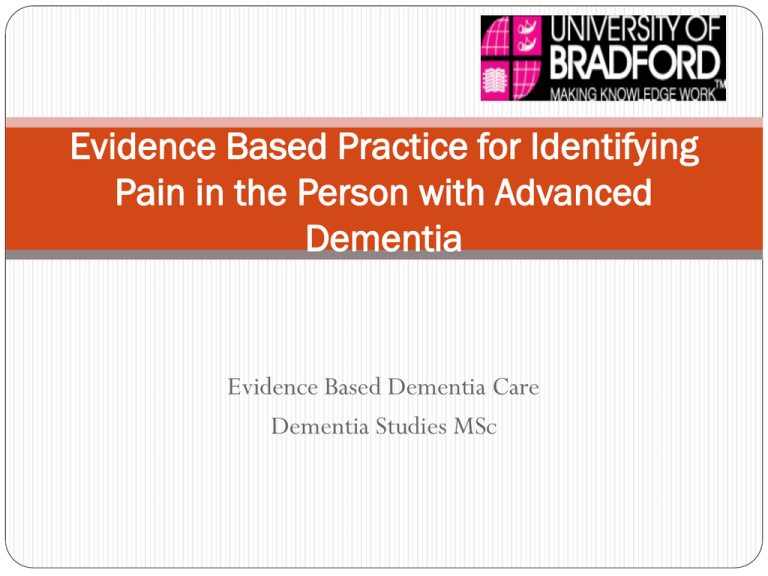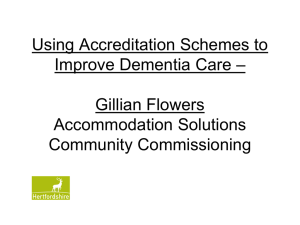pain_and_dementia.for_cpmh_30.6.2014
advertisement

Evidence Based Practice for Identifying Pain in the Person with Advanced Dementia Evidence Based Dementia Care Dementia Studies MSc The Methods Used by Community Mental Health Clinicians to Assess for Pain in People with Dementia who live at Home How many people with dementia experience pain? Why? A. 22% to 45% B. 47% to 66% C. 15% to 22% How many nurses are always assessing for pain in people with dementia on a hip fracture ward? A. 95% B. 88% C. 69% Pain results in ………. For people with dementia Impaired movement ability Most common causes of pain Osteoarthritis Fracture central post stroke pain neuropathies Cancer vascular disease National guidelines specify that all older people are assessed for pain (Department of Health, 2001; BPS and BGS, 2007) How? Self report Behavioural signs of pain Case Study The British Pain Society and British Geriatrics Society (2007) have produced guidance. They do not recommend a particular assessment tool but stipulate that the chosen tool should meet the following criteria: · · · · · · · · Observation of facial expressions Observation for guarding body movements Observing verbalisations Observing changes in interpersonal interactions Observing for changes in mental status Asking the person if they are in pain Observations are during movement Appropriate to the environment Methodology Results Recommendations Reflections References Millions and millions and millions and millions and millions….. Ask and you will receive Thank You References Carson, S. (2006) Organisational Change. In: Hamer S. & Collinson G.eds Achieving Evidence-Based Practice. A Handbook for Practitioners. 2nd Edition. London :BailliereTindall pp175-194 Centre for Reviews and Dissemination (2009) CRD's Guidance for Undertaking Reviews in Healthcare.York: University of York. Department of Health (2007) The National Service Framework for Older Pople. London: Department of Health. Department of Health (2007). Best Research for Best Health. A New National Health Research Strategy. London: Department of Health. Taylor, B. (2006) Personal Change. In: Hamer S. & Collinson G.eds Achieving Evidence-Based Practice. A Handbook for Practitioners. 2nd Edition. London :BailliereTindall pp155-174 The Chartered Society of Physiotherapy (2005) Service Standards of Physiotherapy Practice. London: The Chartered Society of Physiotherapy pp11-12 The Chartered Society of Physiotherapy (2004) Research and Clinical Effectiveness Strategy. London: The Chartered Society of Physiotherapy Colyer, H. (1999) Evidence-based Parctice. A Philosophical and Political Analysis: Some Matters for Consideration by Professional Practitioners. Journal of Advanced Nursing 29(1) pp188-193 Drake, R.E., Goldman, H.H., Leff, S., Lehman, A.F., Dixon, L. Mueser, K.T. & Torrey, W.C. (2001)Implementing Evidence-Based Practices in Routine Mental Health Service Settings. Psychiatric Services 52(2) pp. 179-182 Franks, V. (2004) Evidence-based Uncertainty in Mental Health Nursing. Journal of Psychiatric and Mental Health Nursing 11(1) pp99-105 Sackett, D.L., Rosenberg, W.M.C., Gray, J.A.M., Haynes, R.B. & Richardson, W.S. (1996) Evidence Based Medicine: What it is and What is isn't. British Medical Journal. 312 pp71-72 Seedhouse, D. (2005) Value-Based Decision-Making for the Caring Professionals. West Sussex: John Wiley & Sons Ltd. Centre for Reviews and Dissemination (2009) CRD’s Guidance for Undertaking Reviews in Health Care.York: University of York Colyer, H. & Kamath, P. (1999). Evidence-based practice: A philosophical and political analysis: some matters for consideration by professional practitioners. Journal of Advanced Nursing. 29(1) pp188-193 Grimmer, K., Bialocerkowski, A., Kumar, S. & Milanese. (2004). Implementing evidence in clinical practice: the "therapies" dilemna. Physiotherapy. 90(4) pp189-194 Ilott, I. & White, E. (2001) 2001 College of Occupation Therapist's Research and Development Strategic Vision and Action Plan. British Journal of Occupational Therapy 64(6) Mann, T. (1996) Clinical Guidelines: Using Clinical Guidelines to Improve Patient Care Within the NHS. London: Department of Health NHS Executive. Rosenberg, W., & Donald, A. (1995). Evidence based medicine: an approach to clinical problem solving. British Medical Journal 310 pp1122-1126 Sackett, D.L., Rosenberg, W.M.C., Gray, J.A.M., Haynes, R.B. & Richardson, W.S.(1996).Evidence Based Medicine: What it is and What it isn't. British Medical Journal 312 pp71-72 Sackett, D.L. & Wennberg, J.E. (1997) Choosing the best research design for each question. British Medical Journal 315 pp1636-1637 Taylor, B. (2006) Personal Change In: Hamer S. & Collinson G. eds. Achieving Evidence-Based Practice. A Handbook for Practitioners. 2nd Edition. Published in London by BailliereTindall pp155-174 The Chartered Society of Physiotherapy (1995). The Chartered Society of Physiotherapy Research Strategy. London: The Chartered Society of Physiotherapy pp11-12 The Chartered Society of Physiotherapy (2005). Service Standards of Physiotherapy Parctice. London: The Chartered Society of Physiotherapy pp11-12 The Royal College of Nursing (1996) The Royal College of Nursing clinical effectiveness initiative: a strategic framework. London: Royal College of Nursing. Abbey, J. (2007) Putting pain scales to the test. Australian Nursing Journal 14(7) p43 Cervo, F.A., Raggi, R.P., Bright-Long, L.E., Wright, W.K., Rows, G., Torres, A.E., Levy, R,B. and Komaroff, E. (2007) Use of the certified nursing assistant pain assessment tool (CPAT) in nursing home residents with dementia. American Journal of Alzheimer’s Disease and Other Dementias 22(2) pp112-9. Cervo, F.A., Bruckenthal, P., Chen, J.J., Bright-Long, L.E., Fields, S., Zhang, G. and Strongwater, I. (2009) Pain assessment in nursing home residents with dementia: psychometric properties and clinical utility of the CNA Pain Assessment Tool (CPAT).American Journal of Alzheimer’s Disease and other Dementias 10(7) pp505-10. Chen,Y.H., Lin, L.C. and Watson, R. (2010) Validating nurses’ and nursing assistants’ report of assessing pain in older people with dementia. Journal of Clinical Nursing 19(1-2) pp42-52 Cohen-Mansfield, J. (2006) Pain Assessment in Non-communicative Elderly Persons - PAINE. The Clinical Journal of Pain 22(6) pp569-575 Fuchs-Lacelle, S. and Hadjistavropoulos, T. (2005) A checklist for pain assessment in LTC – PACSLAC: Pain Assessment Checklist for Seniors with Limited Ability to Communicate. Canadian Nursing Home 16(4) pp4-7 Herr, K., Coyne, P.J., Key, T., Manworren, R., McCaffrey, M., Merkel, S., Pelosi-kelly,J. and Wild, L. (2006) Pain assessment in the nonverbal patient: Position statement with clinical practice recommendations. Pain Management Nursing 7(2) pp44-52 Holen, J.C., Saltvedt, I., Fayers, P.M., Hjermstad, M.J., Loge, J.H. and Kaasa, S. (2007) Doloplus-2, a valid tool for behavioural pain assessment?. BMC Geriatrics 19(7) p29 Horgas, A.L., Nichols, A.L., Schapson, C.A. and Vietes, K. (2007) Assessing pain in persons with dementia: Relationships among the non-communicative patient’s pain assessment instrument, self-report, and behavioural observations. Pain Management Nursing 8(2) pp77-85 Husebo, B.S., Strand, L.I., Moe-Nilssen, R., Husebo, S.B., Snow, A.L. and Ljunggren, A.E. (2007) Mobilization-Observation-Behaviour-Intensity-Dementia Pain Scale (MOBID): Development and validation of a nurse-administered pain assessment tool for use in dementia. Journal of Pain and Symptom Management 34(1)pp67-80 Husebo, B.S., Strand, L.I. Moe-Nilssen, R., Husebo, S.B. and Ljunggren, A.E. (2009). Pain behaviour and pain intensity in older persons with severe dementia: Reliability of the MOBID pain scale by video uptake. Scandinavian Journal of Caring Science 23(1) pp180-189 Husebo, B.S., Strand, L.I. Moe-Nilssen, R., Husebo, S.B. and Ljunggren, A.E. (2010).Pain in Older Persons with Severe Dementia. Psychometric properties of the Mobilization-Observation-Behaviour-Intensity-Dementia (MOBID-2) pain scale in a clinical setting. Scandinavian Journal of Caring Science 24(2) pp380-391 Jordan, A., Hughes, J., Pakresi, M., Hepburn, S. and O’Brien, J.T. (2011) The utility of PAINAD in assessing pain in a UK population with severe dementia. International Journal of Geriatric Psychiatry 26(2) pp118-126 Liu, J.Y., Briggs, M. and Closs, S.J. (2010) The psychometric qualities of four observational pain tools (OPTs) for the assessment of pain in elderly people with osteoarthritic pain. Journal of Pain and Symptom Management 40(4) pp582-598 Mahoney, A.E. and Peters, L.(2008) The Mahoney Pain Scale: Examining pain and agitation in advanced dementia. American Journal of Alzheimer’s Disease and other Dementias 23(3)pp250-261 Pautex, S., Herrmann, F.R., Michon, A., Giannakopoulos, P. & Gold, G. (2007) Psychometric Properties of the Doloplus2 Observational Pain Assessment Scale and Comparison to Self-assessment in Hospitalised Elderly. Clinical Journal of Pain 23(9) pp774-779 The British Pain Society and British Geriatrics Society (2007) Guidance on: The assessment of pain in older people. London: The Royal College of Physicians Torvik, K., Kaasa, S., Oyvind, K., Saltvedt, I., Holen, J.C., Fayers, P. and Rustoen, T. (2010) Validation of Doloplus-2 among nonverbal nursing home patients – an evaluation of Doloplus-2 in a clinical setting. BMC Geriatrics 10(9)pp9 Van Iersel, T., Timmerman, D. and Mullie, A. (2006) Introduction of a pain scale for palliative care patients with cognitive impairment. International Journal of Palliative Nursing 12(2) pp54-59 Van Nispen tot Pannerden,M S.C., Candel, M.J.J.M., Zwakhalen, S.M.G., Hamers, .J.P.H., Curfs, L.M.G. and Berger, M.P.F. (2009) An item response theory-based assessment of The Pain Assessment Checklist for Seniors with Limited Ability to Communicate (PACSLAC). The Journal of Pain 10(8) pp844-853 Zwakhalen, S.M.G., Hamers, J.P.H., Abu-Saad, H.H. and Berger, M.P.F. (2006) Pain in elderly people with severe dementia: A systematic review of behavioural pain assessment tools. BMC Geriatrics 6,3. Zwakhalen, S.M., Hamers, J.P. and Berger, M.P. (2006) The psychometric quality and clinical usefulness of three pain assessment tools for elderly people with dementia. Pain 126(1-3) PP210-220 Zwakhalen, S.M.G., Hamers, J. and Berger, M.P.F. (2007) Improving the clinical usefulness of a behavioural pain scale for older people with dementia. Journal of Advanced Nursing 58(5) pp493-502









